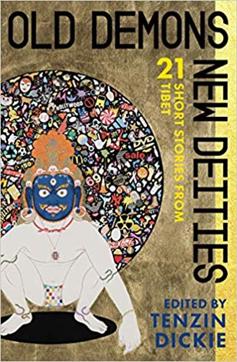Review: Old Demons New Deities edited by Tenzin Dickie
This collection of short stories is the first attempt to provide a common and influential platform to some of the best Tibetan writers.

People say don’t judge a book by its cover. That’s a fair comment. Some of the greatest books had lousy covers. But these books with lousy covers shaped people’s thinking and sustained their chosen way of life. However, the cover of Old Demons New Deities cries out for attention and judgment. The cover is dominated by a deity, a cross between a Buddhist and Hindu god, who has his back to the modern world. Here the modern world is epitomized by the oil giant Shell, Coco Cola, Bollywood, Spiderman, Tintin and other brands. Though the deity has turned his back on it, the modern world is creeping up on him. Perhaps unknown to him, he wears multicoloured underpants that reflect the world he has turned his back on.
The Tibetan writers Tenzin Dickie has brought together in her anthology grapple with issues of Tibetan identity in the modern world both in Tibet and in the free world. In Tibet, modernity was initially imposed in the form of communism with an emphasis on equality, tearing down the exploiting ruling class, and ‘liberating’ the toiling masses. Now Tibetans in Tibet suffer crony capitalism supervised by the ruling Chinese Communist Party which has made China one of the most unequal societies in the world. This transformation has compelled China to shift from ‘liberating’ the Tibetan people to liberating Tibet’s resources to China. China conducts a strange import-export business with Tibet, importing its mineral and other abundant resources to China and exporting its excess population. As a result of that initial imposition, in 1959 around 86,000 Tibetan refugees followed the Dalai Lama into exile. In their uprooted condition, they found everything was new and strange except the self same earth and sky.
This was not Tibet’s first contact with the outside world. The first encounter took place during the imperial age from the 6th to the 9th century AD when the expansionist ambitions of successive Tibetan emperors brought the people face to face with highly developed cultures. One of them was Buddhism, which the Tibetans embraced with unsurpassed devotion and energy. From an empire Tibet was transformed into a civilization. Some Tibetans say this was a bad thing. It sapped Tibetan energy and spirit and the outcome is Tibet’s present tragic fate. Others say it was a good thing. Tibetan civilization spilled over an area larger than ancient Tibet and is now a culture without boundaries that has seeped into global consciousness. Whatever the case, people responsible for this transformation were the great Tibetan masters and translators who, over a period of 500 years, had the complete body of Buddhist wisdom incorporated into the Tibetan language.

In exile today the Tibetan fascination is with democracy which, under the Dalai Lama, the Tibetan exiles have incorporated into their body politic with gusto. One result is a vibrant Tibetan civil society in which individual Tibetan exiles have the freedom to think and write freely, a redeeming condition of living in the free world. The Tibetan writers Tenzin Dickie has brought together in her book play a role similar to the one played by ancient Tibet’s great translators. This time, they are explaining Tibet to the world. Tenzin Dickie says the writers she has folded into her book come from far apart as Tibet, China, India, Nepal, US and Canada. The chosen medium of their message, a reflection of Tibet’s present displacement, is English, Tibetan and Chinese, all translated into English. This is the first time an attempt has been made to provide a common and influential platform to some of the best Tibetan writers. Dickie hopes this anthology will constitute a coming-of-age for the Tibetan short story, and for Tibetans telling Tibet’s tale to the rest of the world. All keepers of the Tibetan flame.
Read more: Book review: A Home in Tibet by Tsering Wangmo Dhompa
This anthology includes works by courageous and established literary figures. One is Woeser, a tireless blogger operating out of Beijing and virtually confined in the Chinese capital. Jamyang Norbu, another tireless blogger and great writer, has contributed two short stories. So has Pema Bhum, who was educated in Tibet but has since relocated to New York and teaches at Columbia University. Tsering Wangmo Dhompa’s A Home in Tibet took the Tibetan literary world by storm. She teaches creative writing in the US.
Then there are new literary talents who tell the story of the outcome of Tibet’s interface with the modern world. One story, The Valley of the Black Foxes, does not bode well. Tsering Dondrup, whose works have been translated into multiple languages, writes, “When they finally reached the pass leading into the Valley of the Black Foxes, the sight that met their eyes shocked them… The entire valley was dug out. There were cranes, conveyer belts, tractors, and machines everywhere.”
Vultures circling easy prey?



